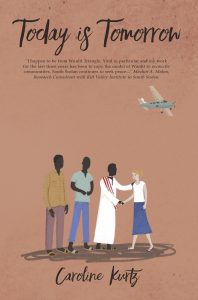Caroline Kurtz: On Writing Memoir
 With my husband and sons, I moved mid-career to Nairobi, Kenya from a teaching job in Ethiopia. We’d been asked to work for four years with Nuers, the second largest ethnic group in South Sudan. It was a misbegotten and doomed assignment. Trauma from the Sudanese civil war, now in its thirtieth year, pressed on everyone, always, and everywhere. Corruption ruled. I empathized—it was fueled by the desperation of being refugees in Nairobi. And I resented—it drained away funds for my work with women in burnt-out villages.
With my husband and sons, I moved mid-career to Nairobi, Kenya from a teaching job in Ethiopia. We’d been asked to work for four years with Nuers, the second largest ethnic group in South Sudan. It was a misbegotten and doomed assignment. Trauma from the Sudanese civil war, now in its thirtieth year, pressed on everyone, always, and everywhere. Corruption ruled. I empathized—it was fueled by the desperation of being refugees in Nairobi. And I resented—it drained away funds for my work with women in burnt-out villages.
Later, when I had minor surgery in Nairobi, I came up from anesthesia sobbing. A Kenyan nurse stood close, patting my shoulder.
“I want to write a book!” I wailed, barely awake.
“It’s okay, Madam. You can write a book,” she said.
The next week, I went to Uchumi’s Supermarket and bought what they had: a scentless paraffin candle in garish royal blue. Day after day, laying aside my frustration, I lit the candle, put on inspiring music, and wrote.
I wrote what every inexperienced memoirist writes: a litany of circumstances that I thought would tell my story—a beloved childhood home in Ethiopia, painful otherness in a US college, a job in Africa that offered hope for carving out an adult home there.
It took many years and many rewrites for those pages to become a memoir. They were full of this, then this, then this. They were thin on how my experiences looked, smelled or felt to the touch. They didn’t yet reveal how events hit me, or how I was left as they swept on.
I had to run the memory-tapes over and over until I could smell the green musk of ferns and feel the bite of an Ethiopian mountain stream where my sisters and I floated our fern-babies. Until I could see the bleak cornfields and cities of the US Midwest surroinding me in college. Until I could taste again the syrup-sweet spiced tea I drank with Ethiopian teacher friends.
After trips into Sudan, new stories also poured out of me by the light of my candle—stories of living in tents and grass huts, bathing by cupful, eating sorghum that crackled with bits from grinding stones. But these stories were not complete, either. They only skirted my wonder at getting to live among Nuers in Sudan; my shock at their resilience in extreme deprivation; my sorrow that I could not do more to relieve their isolation, their fear of further violence, the memories of death they carried.
And for a long time, my stories lacked the emotional arc that would hold them together. I found the arc as I revised: yes, I had longed to go back to Africa. Once there, what a disappointment—the only differences I could make were very small, very personal. Finally, I came to accept that what I could give to Africa was really only myself. I rewrote until one day, out of my typing fingers came wry acceptance in a perfect last line.
But my editor, JL Powers of Catalyst Press, saw that I was still crowding the story. She asked me to divide what I’d written into two books: Down on Both Sides: Growing up in America and Ethiopia, and Today is Tomorrow.
I found that my hard-earned emotional arc had become a solid thing. I had to cut it, as though with tin snips, and bend it into two new arcs, a process almost as hard as writing the book in the first place.
I dug down and down to find the first arc. I remembered confusion—should I have been satisfied with my childhood experience of parents’ and teachers’ American culture mixed with bits of Ethiopia that enriched, warped and enlarged it? Did delight in adult immersion and language competence make up for all the raw edges where my two cultures now tore at each other?
“You don’t know the heart of these Africans,” an Ethiopian friend said about Tigrayan guerillas, who marched in to take the capital in 1991. I would never be fully Ethiopian.
To find the arc of my second book, I looked for what I had still hoped for as we set out for southern Sudan. I had crept under the edges of the blanket of life in Ethiopia. Surely, I could do that again. I had learned Amharic. Surely, I could learn the African language and Juba Arabic I needed in order to speak with Nuer women in southern Sudan. Surely, I could do something to ameliorate their suffering.
I had never expected working in Africa to be easy. But I was entirely unprepared for what Sudan required of me: making decisions that might mean life or death for others. When I asked my editor what she liked about my second book, she said, “It’s a story of failure. That’s unusual.”
My years in Africa had been unusual. And hard. I also spent years in the US feeling disconnected and lonely, afraid I would never find a place where I could settle.
Even before publication, I found that the process of creating art out of my stories opened my heart, inviting others to join me in their imaginations. Enriching my stories with physical and emotional detail showed me that I am connected with any human who wants meaning in life, makes mistakes, worries about their kids and their marriage, and survives soul-rattling events.
This is the joy of both reading and writing memoir—under the spotlight, details of a specific life reveal the universal. Truth glows. And as the Nuer Chief Isaac said to me, even stranded as we were in enemy territory, “We are home.” We are always home.
—
Caroline Kurtz is a citizen of two cultures. As a child in Ethiopia, she absorbed sights, sounds, smells and customs of Africa, the subject of her memoir Down on Both Sides: Growing up in America and Ethiopia. Later, with her husband and three children she taught, advocated for women and supported peacemaking in Ethiopia and Sudan—described in her second memoir, Today is Tomorrow.
Fluent in Ethiopia’s Amharic language, Caroline bridges between donors and community-led projects: sheep banks, bee-keeping, and a highland apple orchard. She has raised funds for Muslim villages building themselves schools. She supported developing an alphabet and mother-tongue literacy for the oral language of her home area in Maji, Ethiopia. Now she works with community leaders (in Amharic over Skype-to-phone during Covid) to bring solar energy, clean water and women’s empowerment in Maji. She also writes and designs bilingual early-reader books for Ethiopian children. When she’s not on the road raising money in the US and midwifing projects in Ethiopia, Caroline lives in Portland, Oregon across the street from 3000 rose bushes.
Twitter: @Caroline_Kurtz_ Instagram: @carolinejkurtz Facebook: @carolinejkurtz
TODAY IS TOMORROW
Category: How To and Tips

 By 1996, millions of South Sudanese have been killed, died of starvation, or fled the decades-long civil war ravaging their country. So when the Presbyterian Church in the United States begins recruiting a development team to work with war refugees in the region, Caroline and her husband Mark are eager to help. But it’s only months before ghosts from their individual pasts whistle in to disrupt their marriage and their new postings.Caroline finds relief in teaching and peace work in South Sudan, but the heavy responsibility she now carries for dozens of vulnerable families―coupled with the prevailing ideas of Biblical womanhood that put pressure on her personal life―makes it increasingly clear that Caroline is under-prepared for the high-stakes crisis in which she is now embedded.
By 1996, millions of South Sudanese have been killed, died of starvation, or fled the decades-long civil war ravaging their country. So when the Presbyterian Church in the United States begins recruiting a development team to work with war refugees in the region, Caroline and her husband Mark are eager to help. But it’s only months before ghosts from their individual pasts whistle in to disrupt their marriage and their new postings.Caroline finds relief in teaching and peace work in South Sudan, but the heavy responsibility she now carries for dozens of vulnerable families―coupled with the prevailing ideas of Biblical womanhood that put pressure on her personal life―makes it increasingly clear that Caroline is under-prepared for the high-stakes crisis in which she is now embedded.






















